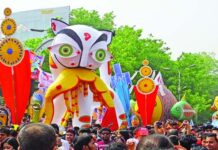Breaking the ‘Dhaka Myths’

It does not matter where you live, because if you are a Bangladeshi, you have already come across these expressions: “Dhakai Taka Oore” roughly translated as “Dhaka is the city of opportunities”. And if you are a Dhaka dweller, you are most likely living inside this bubble—greatly shaped by the Bangladeshi commercial cinema industry.
Interestingly, the middle-class elites are the ones who have propagated these fancy myths about Dhaka in popular media such as films, literature, newspapers, and so on. For instance, if we look at our post-independence films, we will frequently come across cult dialogues like “Dhakai Taka Oore”. In the mainstream films of the 80s and the 90s, there was one single common theme in most of our movies: a protagonist or a protagonist’s family migrating from a village to Dhaka for economic emancipation. These film narratives, on the one hand, reflected the spatio-temporal realities of our society and, on the other hand, constructed an image, or disseminated an already established image, of Dhaka as a city of opportunities where money was an easy catch. Such cinematic projection of Dhaka made it a space of “growth” where everyone (except for the upper class) fought for success.
Please do not get me wrong because I am not suggesting at all that the popular films have inspired migration to Dhaka city. Rather, I am suggesting that popular media and culture constructed an image of a better life in Dhaka in a way that the “Dhakai Taka Oore” concept has become permanently embedded in the psyche of the mass people. The representation of a fortune-changing city in local films boosted the mythic construction of Dhaka. A hero comes to Dhaka and becomes a millionaire all on a sudden as if he has found Aladdin’s lamp. Dhaka worked as a magic space.
Also, if you can remember how Dhaka was actually portrayed in the same movies of that period, you will be able to recollect the stereotypical duplex luxury villa (at that time private apartments were not common), where an aristocratic Chowdhury Shaheb lived. Such representation enters our cultural discourse with a vibe that Chowdhury Shahebs generally live in Dhaka. The social power of these Chowdhury Shahebs represent Dhaka’s hierarchy and spatial hegemony. This is how Dhaka’s mythic impression unconsciously became a cultural norm.
As mentioned before, the middle-class elite of our society propagated these myths producing a cultural desire among others to come to Dhaka in search of monetary and social success. The messages are simple: you go to Dhaka, struggle there, get a good job, meet successful people, and eventually hit the jackpot in terms of money and career. All good schools are in Dhaka, the best teachers teach in Dhaka, Dhaka University is the best, big shopping malls are in Dhaka, Dhaka is a city of the tallest buildings, the night life of Dhaka is amazing, Dhaka means dynamism, whatever happens in Dhaka is a headline, Dhaka means big jobs and a hefty salary, etc. One might at this point ask: are these all truths? Or are they just fancy illusions of Dhaka’s capitalistic growth? I do not consider such growth as “development”, as for me Dhaka is a perennial misery (in terms of growth) at the centre of Bangladesh.
However, the cultural desire, which has penetrated into the nation’s subconscious has transformed Dhaka into a centre while all other regions appear peripheral. The construction of such fancy myths has generated a central hierarchy in our socio-cultural discourse. We have placed Dhaka as the centre of everything, which has encouraged a good number of people from other regions to migrate to Dhaka. This migration is not bad, because it happens to each metropolis around the world. But it is threatening in case of Dhaka because of its infrastructure which cannot continue to absorb the constant flow of people from the rest of the country.
Such myths that represent Dhaka as a place of endless opportunity and wealth have damaged Dhaka’s possibility of being a healthy, planned and beautiful city. Dhaka is facing the pressure of being the centre of everything such as politics, economy, social life, culture, career, administration and so on. Decentralisation is the only way to save Dhaka and it has to take priority in policy making. But that is the job of the government and the policy makers. But how can we break the myths already inculcated into our socio-cultural discourse, and how can we break the consequences resulting from the production of these myths?
People have taken the myths as axiomatic truths, so they feel comfortable inside the bubble. The whole city is stuck and studded with problems: water crisis, population density, lack of security, huge traffic, corruption, etc. But you can still ask anybody about leaving Dhaka and going to a different place to settle. You will find that nobody is planning to leave Dhaka, the city of opportunities, even though everyone knows living in Dhaka is kind of living in a hell. It is now a stock-still city, unmoved and unnecessarily crowded. You can come down to Dhaka’s street on a regular day, and you will understand how a city has reached the verge of zombification. The 400-year-old Dhaka is suffering from the consequence of our system malfunctioning in every possible way. I do not know how we can save Dhaka. But we can at least free Dhaka from being burdened by the myths by honestly representing the city in our films, dramas and other media narratives.
Anupam Kamal Omi is pursuing MA in English Language and Culture at University of Eastern Finland.









